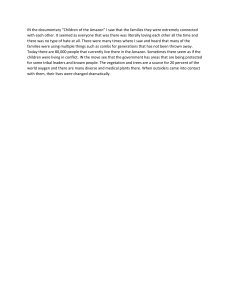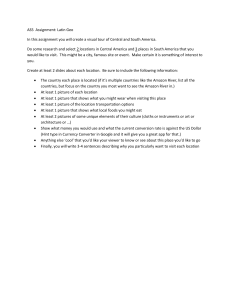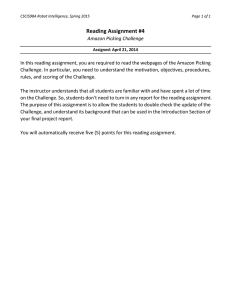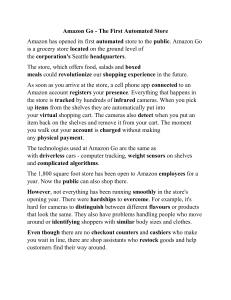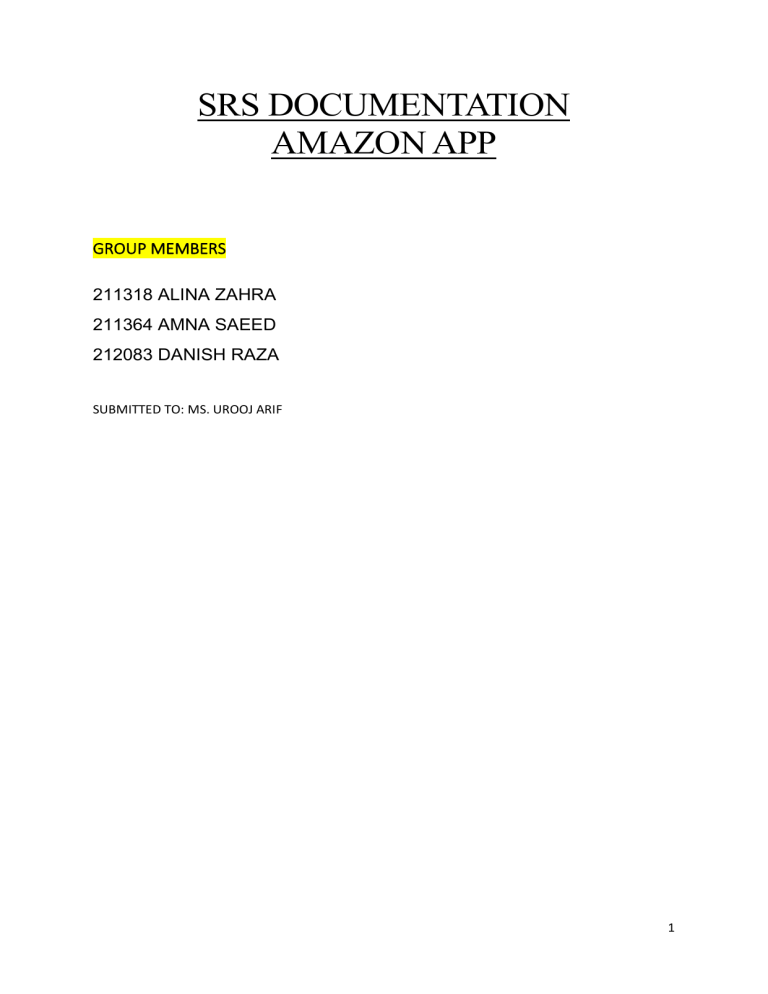
SRS DOCUMENTATION AMAZON APP GROUP MEMBERS 211318 ALINA ZAHRA 211364 AMNA SAEED 212083 DANISH RAZA SUBMITTED TO: MS. UROOJ ARIF 1 2 TABLE OF CONTEXT (SRS document) INTRODUCTION: 1. introduction 2. Document Convection 3. Intended Audience 4. Reading Suggestion 5. Reference 6. Purpose 7. Scope 8. Risk Analysis 9. Definition, Acronyms and Abbreviations 10. Overview OVERALL DESCRIPTION: 2.1 Product Perspective 2.2 Product Function 2.3 User Characteristics 2.4 Operating Environment 2.5 Design and Implementation Constraints 2.6 User Documentation 2.7 Assumption and Dependencies 3 SPECIFIC REQUIREMENTS 3.1 Functional Requirements 3.1.1 Registration 3.1.2 Login 3.1.3 Changes to Cart 3.1.4 Payment 3.1.5 Log out 3.1.6 Report generation 3.2 Non-Functional Requirements 3.2.1 Usability 3.2.2 Graphical User Interfaces 3.2.3 Accessibility 3.2.4 Reliability and Availability 3.2.5 Back and Internal Computers 3.2.6 Internal Service Provider 3.2.7 Performance 3.2.8 Security 3.3 Design Constraints 3.4 Interfaces 3.5 Supplementary requirements 3.6 Diagram 4 EXTERNAL INTERFACE REQUIREMENTS 4.1 Software Interface 4.2 Communication Interface 4.3 User Interface 4.4 Hardware Interface PERFORMANCE REQUIREMENTS 5.1 Safety Requirements 5.2 Security Requirements 5.3 Software Quality Attributes 5.4 Business Rules 5 Amazon 1.1 Introduction Amazon is basically a website which provides a best online shopping. Amazon.com, Inc., known as Amazon (/ˈæməˌzɒn/), is an American online business and cloud computing company. It was founded on July 5, 1994 by Jeff Bezos. It is based in Seattle, Washington. It is the largest Internetbased store in the world by total sales and market capitalization. Document Convention: The Amazon Basin is governed by two multilateral conventions: The Amazon Cooperation Treaty, which was adopted in Brasilia, Brazil on 3 July 1978 and entered into force on 2 August 1980; According to Article XVI, the Amazon Cooperation Treaty shall not “be to the detriment of projects and undertakings executed within their respective territories, according to International Law and fair practice between neighboring and friendly countries.” In addition, under Article XIX, the Amazon Cooperation Treaty does not have an effect on any other international treaties in effect between the Member States or any differences that exist between the Member States concerning their limits or territorial rights. Intended audience: Amazon's target market is middle and upper-class consumers (evenly split between genders) with home computers or smart devices aged between 18-44 as of 2022. Additionally, 60% of Amazon's target market are from the United States who prefer shopping online for convenience, fast delivery, and competitive prices. Reading suggestion: Amazon provides a lot of stuff on its own website and other related website for reading the amazon website and for better understanding . There is amazing booklets on google . actually through reading suggestion a costumer know about the website to find the product according to its desire . Reference: 1: Jeff Bezos founded Amazon.com (executive Chair) 2: Amazon.com first time founded in 1994(Created Date) 3: Amazon.com (page title) 4:URL (https://www.amazon.com/) 1.2 Purpose: The Purpose of amazon is to continually raise the bar of the customer experience by using the internet and technology to help consumers find, discover and buy anything, and empower businesses and content creators to maximize their success. 6 (Ref: Google.com) 1.3 Scope: Amazon is often recognized for its success as an online retailer, but another one of the company's core business units is its extensive list of subscription services. ... Prime, Amazon's main subscription service, provides shipping and delivery benefits and online shopping discounts. 1.4 Risk Analysis • • • • • • • • Seven Types of Risk Analysis Every Energy Trader Should Know Value-at-Risk. ... Mark-to-Market. ... Counterparty Credit Exposure. ... Counterparty Collateral Requirements. ... Cost of Credit. ... Hedge Effectiveness Test. ... Stress Testing. 1.5 Definitions, Acronyms and Abbreviations There are some key points which define amazon website interface and through which we are able to do online shopping through amazon. Website – A address that is connected to the internet to provide one or more web pages or other content. Online – Connected to a computer network or accessible by computer Browse – Reading superficially or at random Search – The activity of looking thoroughly in order to find something Shopping cart – A handcart that holds items (groceries or other goods) while shopping. Checkout – Confirm and pay goods (or services) using a payment facility References Amzon.com (Amazon.com. Spend less. Smile more.) 1.6 Overview The SRS of amzon.com is divided into two main parts: Overall Description and Specific Requirements. The Overall Description describes the requirements at a high level, while the Specific Requirements describe all of the relevant requirements of the system. 7 2. OVERALL DESCRIPTION 2.1 Product Perspective The online shopping system allows the actor (web customer) to use the Amazon website to make purchases online. The top-level features are to allow the actor to browse the website as a guest user or log in as a registered user. The browse and search items can be used by customer as primary feature use case if the customer only wants to find and see some products. The search and browse Items use case is extended by several optional use cases - customer may search for items, browse catalogue, view and select these items, add them to shopping cart and view the shopping cart. All these use cases are extending use cases because they provide some optional functions allowing customer to find item. The second set of features allows the actor to make purchase. The make purchase use case requires the customer to either use the buy item now option with one click payment authentication and verification (available only to registered users) to place the order or go through the checkout use case. In the checkout use case, customer provide the shipping address, and then specific the method of payment which can be done either by using credit card or with bank account. After providing the payment method, customer will review and order item. https://www.academia.edu/39415309/Amazon_com_Inc_Software_Requirements_Specification_For _Online_Shopping 2.2 Product Function The function of this app is described below = • Login • Search the product • Give related product list according to the demand of the user • Click on the product to view the details • Show all the specifications and reviews of the product • Add the product in the cart when “Add to cart” button is pressed • Show the items in the cart when “cart” icon is clicked • Go to payment procedure • Add the details like: address, phone number, full name and email address etc. • Confirm order through email • Tracking the order through email 8 2.3 User characteristic this system will be used by the customers for online shopping of everything. The main user is shopkeeper, buyer, the delivery service. It does not need proper knowledge of the system to use it. It is self-explanatory. And if the user need help the help guide is available. 2.4 Operating environment = This system can be used on window XP, window 7, window 10, android operating system and IOS etc. 2.5 Design and implementation constraints = this system will be made on html.CSS and C++ on back end. Decision regarding which database to use should be taken considering the fact that data being exchanged or stored is large, and the appropriate data management system will yield efficient performance. 2.6 User documentation = User documentation include (online help and user manual). 2.7 Assumption and dependencies = It is assumed that you can use this app offline but you cannot. It is dependable on proper net and proper operating system. 3. SPECIFIC REQUIREMENTS 3.1 FUNCTIONAL REQUIREMENTS Various functional modules that can be implemented by the system. The functional requirements of Amazon are discussed below: 3.1.1 Registration If customer wants to buy the product, then he/she must be registered, unregistered user can’t go to the shopping cart. 3.1.2 Login Customer logins to the system by entering valid user id and password for the shopping. 3.1.3 Changes to Cart Changes to cart means the customer after login or registration can make order or cancel order of the product from the shopping cart. 3.1.4 Payment In this system we are dealing the mode of payment by Cash. We will extend this to credit card, debit card etc in the future. 3.1.5 Logout After ordering or surfing for the product customer has to logout. 9 3.1.6 Report Generation After ordering for the product, the system will sent one copy of the bill to the customer’s Email-address and another one for the system data base. 3.2 NON-FUNCTIONAL REGUIREMENTS 3.2.1 Usability 3.2.2 Graphical User Interface • • • The system shall provide a uniform look and feel between all the web pages. The system shall provide a digital image for each product in the product catalog. The system shall provide use of icons and toolbars. 3.2.3 Accessibility • • The system shall provide handicap access. The system shall provide multi language support. 3.2.4 Reliability & Availability 3.2.5 Back-end Internal Computers • • • The system shall provide storage of all databases on redundant computers with automatic switchover. The system shall provide for replication of databases to off-site storage locations. The system shall provide RAID V Disk Stripping on all database storage disks. 3.2.6 Internet Service Provider • • The system shall provide a contractual agreement with an internet service provider for T3 access with 99.9999% availability. The system shall provide a contractual agreement with an internet service provider who can provide 99.999% availability through their network facilities onto the internet. 3.2.7 Performance • • • The product shall be based on web and has to be run from a web server. The product shall take initial load time depending on internet connection strength which also depends on the media from which the product is run. The performance shall depend upon hardware components of the client/customer. 3.2.8 Security Data Transfer • • • The system shall use secure sockets in all transactions that include any confidential customer information. The system shall automatically log out all customers after a period of inactivity. The system shall confirm all transactions with the customer’s web browser. 10 • • The system shall not leave any cookies on the customer’s computer containing the user’s password. The system shall not leave any cookies on the customer’s computer containing any of the user’s confidential information. Data Storage • • • • • The customer’s web browser shall never display a customer’s password. It shall always be echoed with special characters representing typed characters. The customer’s web browser shall never display a customer’s credit card number after retrieving from the database. It shall always be shown with just the last 4 digits of the credit card number. The system’s back-end servers shall never display a customer’s password. The customer’s password may be reset but never shown. The system’s back-end servers shall only be accessible to authenticated administrators. The system’s back-end databases shall be encrypted. 3.3 Design Constraints • • 1. 2. 3. 4. 5. • Standard Development Tools Web Based Product There are no memory requirements The computers must be equipped with web browsers such as Internet explorer. The product must be stored in such a way that allows the client easy access to it. Response time for loading the product should take no longer than five minutes. A general knowledge of basic computer skills is required to use the product On-line User Documentation and Help System Requirements As the product is E-store, On-line help system becomes a critical component of the system which shall provide specific guidelines to a user for using the E-Store system and within the system. To implement online user help, link and search fields shall be provided. 3.4 Interfaces Various interfaces for the product could be 1. Login Page 2. Registration Form 3. There will be a screen displaying information about product that the shop having. 4. If the customers select the buy button then another screen of shopping cart will be opened. 5. After ordering for the product, the system will sent one copy of the bill to the customer’s Email address 3.5 Supplementary Requirements There are a couple of non-functional requirements that are associated with this software system. • • The website shall run on all browsers. The website shall support screen reader software for disabled people and follow 508 standards. 11 DIAGRAM 4.0 External Interface Requirements Interface requirements include: Various interfaces for the product could be 1). Login Page 2). Registration Form 3). There will be a screen displaying information about product that the shop having. 4). If the customers select the buy button, then another screen of shopping cart will be opened. 5). After ordering for the product, the system will send one copy of the bill to the customer’s Email address. 4.1 Software Interface AWS (Amazon Web Services) is a comprehensive, evolving cloud computing platform provided by Amazon that includes a mixture of infrastructure as a service (IaaS), platform as a service (PaaS) and packaged software as a service (SaaS) offering. AWS services can offer an organization tool such as compute power, database storage and content delivery services. AWS launched in 2006 from the internal infrastructure that Amazon.com built to handle its online retail operations. AWS was one of the first companies to introduce a pay-as-you-go cloud computing model that scales to provide users with compute, storage or throughput as needed. 12 AWS offers many different tools and solutions for enterprises and software developers that can be used in data centres in up to 190 countries. Groups such as government agencies, education institutions, non-profits and private organizations can use AWS services. AWS is separated into different services; each can be configured in different ways based on the user's needs. Users should be able to see configuration options and individual server maps for an AWS service. 4.2 Communication Interface The Web Real-Time Communication (WebRTC) standard supports sending real-time video, audio, and arbitrary data between two peers. Amazon supports WebRTC to enable real-time streaming of audio, video, and (optionally) arbitrary data between Alexa and your smart home device. Alexa communicates commands over the real-time communication (RTC) data channel to your device, and then your device responds and reports state back over the data channel. 4.3 User Interface The user interface for the software shall be compatible to any browser such as Internet Explorer, Mozilla or Netscape Navigator by which user can access to the system. The user interface shall be implemented using any tool or software package like Java Applet, MS Front Page, EJB etc. 4.4 Hardware Interface Since the application must run over the internet, all the hardware shall require to connect internet will be hardware interface for the system. As for e.g. Modem, WAN – LAN, Ethernet Cross-Cable. 5.0 SOFTWARE QUALITY ATTRIBUTES: software Quality Attributes are features that facilitate the measurement of performance of a software product by Software Testing professionals, and include attributes such as availability, interoperability, correctness, reliability, learnability, robustness, maintainability, readability, extensibility, testability, efficiency, and portability. High scores in Software Quality Attributes enable software architects to guarantee that a software application will perform as the specifications provided by the client. 5.1 Business rules: A business rule is a constraint of the business itself that may guide system development. It is a rule that must be followed, no matter what else is happening. It often involves very specific criteria or conditions for compliance. All users need a valid email address.in amazon we need whole information of the customer and the shopkeeper their address, cell phone number, email address, name and CNIC etc. to make the business affective and easy to use. 5.2 Performance The system must be interactive and the delays involved must be less . 5.3 Safety Information transmission should be securely transmitted to server without any changes in information. 13 5.4 Reliability The system must be interactive and the delays involved must be less. So in every action-response of the system, there are no immediate delays. In case of opening windows forms, of popping error messages and saving the settings or sessions there is delay much below 2 seconds, in case of opening databases, sorting questions and evaluation there are no delays and the operation is performed in less than 2 seconds for opening, sorting, computing, posting > 95% of the files. Also, when connecting to the server the delay is based editing on the distance of the 2 systems and the configuration between them so there is high probability that there will be or not a successful connection in less than 20 seconds for sake of good communication. SECURITY REQUIREMENT • • • • • The system uses SSL (secured socket layer) in all transactions that include any confidential customer information. The system must automatically log out all customers after a period of inactivity. The system should not leave any cookies on the customer’s computer containing the user’s password. The system’s back-end servers shall only be accessible to authenticated administrators. Sensitive data will be encrypted before being sent over insecure connections like the internet. 14
